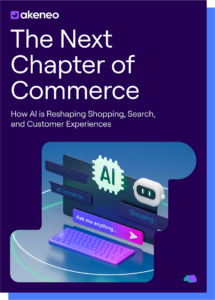Explore why outdated SEO tactics no longer meet the demands of today’s search behavior—and how to adapt. From intent-focused strategies to the role of PIM in improving product content, learn how to make SEO more effective, relevant, and human-centered.

Keywords
Some of the world’s greatest inventions are high-tech smartphones, well-optimized coffee machines, and SEO. But while your phone keeps getting smarter and your coffee machine somehow knows exactly when to brew that next cup, businesses’ use of SEO is old-fashioned, failing to keep up with how real people actually search. It’s become a bit like using a paper map in the age of GPS—technically useful, but often archaic and far from flexible.
While many companies are using SEO, some still struggle to use it effectively, which means missing out on meaningful customer insights and even deterring potential buyers. As you can see, bad SEO can make or break your business. Instead of attracting the right audience, it can push them away. But what does poor SEO really look like? And how can you avoid making the same mistakes with your brand? Well, let’s find out!
Search Engine Optimization (SEO) is the practice of improving a website’s visibility, content relevance, and ranking on search engine results pages (SERPs) for specific keywords. The goal is to attract more organic (non-paid) traffic by aligning businesses’ content with what people are actively searching for.
To achieve this, brands create content that directly addresses their customers’ questions—using the right keywords, structuring pages for readability, and ensuring the site is fast, mobile-friendly, and easy to navigate. SEO involves optimizing everything from meta tags and headers to internal links and page speed, all to help search engines understand your content and connect it with the right users. When done well, SEO helps brands appear naturally in the moments that matter most!
But as valuable as SEO is, there are some drawbacks to the traditional SEO strategies that have become particularly evident as AI-powered search experiences have started to take the spotlight.
Traditional SEO often focuses on exact-match keywords, assuming users search in a predictable, uniform way. But in reality, people use conversational language, ask full questions, and vary their phrasing based on intent, location, or even mood. Focusing only on static keywords means your content may fail to appear in more meaningful, high-intent searches—where potential customers are actually looking for what you offer.
If your content is stuck chasing exact matches instead of understanding the bigger picture, you’re missing out on opportunities to show up for the searches that actually matter.
Another big issue? Traditional SEO often oversimplifies search intent. It lumps users into broad categories rather than recognizing that someone casually researching a product and someone ready to buy might use very different wording.
Yet outdated SEO strategies treat them the same; or worse, force marketers to play a guessing game as to what customers really mean when they search.
And let’s not forget how fast search behavior changes. Sticking to a rigid set of keywords means you’re optimizing for yesterday’s searches instead of adapting to what people are looking for today and tomorrow. Businesses that cling to rigid keyword strategies may find themselves losing visibility to competitors who embrace more dynamic, AI-driven, and conversational approaches to content discovery.
Despite these limitations and the growing push for AI-powered intent-based searching, traditional search experiences aren’t going anywhere. But focusing on strategies that prioritize user-friendly content, seamless user experience, well-optimized pages, and adaptability can help businesses ensure that they are utilizing these traditional SEO engines effectively. A few key tips include:
When SEO is approached with strategy and empathy, it becomes less about algorithms and more about connection, which is the best way to understand and communicate with your customers.
Strong SEO doesn’t start and stop at keywords. It depends on the quality, consistency, and completeness of your product data, which is where a Product Information Management (PIM) system comes in. PIM helps businesses centralize and manage product content across all channels, ensuring that information is accurate and up-to-date whether it’s appearing on a website, an app, or a third-party marketplace. This consistency is key not only to building trust with customers but also to optimizing for search engines, which reward relevance, structure, and completeness.
When product data lives in silos or is spread across disconnected systems, it creates gaps in customer experience and weakens your SEO foundation. In fact, poor data quality and data silos cost companies an average of $12.9 million annually, and 84% of retail executives admit to struggling with data silos. These inconsistencies can lead to incomplete product descriptions, conflicting information, misaligned keywords, and missed opportunities to appear in searches. PIM solves this by creating a single source of truth for all your product content!
A well-implemented PIM also enhances personalization and user engagement—both of which influence search rankings. By pulling together product data, customer feedback, and user-generated content (UGC) from across touchpoints, brands can create more targeted, SEO-friendly content that resonates with how people actually search and shop.
In short: the better your product data, the stronger your SEO! PIM gives you the foundation to deliver consistent and search-optimized content across every channel—helping you win in both discovery and conversion.
SEO today is about far more than just keywords and rankings; it’s about relevance, context, and creating frictionless experiences that match how real people search. Traditional strategies that focus solely on static keywords or guess at intent are quickly becoming outdated. If your brand wants to stay visible and competitive, it needs to evolve with the way customers think, speak, and shop.
That’s where strong product data and tools like PIM make all the difference. By centralizing and enriching your product information, you create a foundation for more accurate, personalized, and search-optimized content across every channel. When you combine that with a customer-first mindset, SEO stops being a guessing game and starts becoming your best strategic advantage.
Discover how AI is transforming shopping, search, and product experiences, and why clean, structured data is the key to staying competitive in the next era of commerce.


Learn how brands like Perplexity, Sephora, OpenAI, and Amazon are leveraging AI to reshape the customer journey—from intent-based search and...
Read more
Leading analyst firms IDC and ISG have released their 2025 assessments of Product Information Management (PIM) and Product Experience Management...
Read more
Discover how businesses are using PIM to prepare for the EU’s Digital Product Passport (DPP)—centralizing product data, enabling supply chain...
Read more